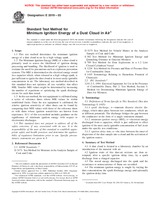Potřebujeme váš souhlas k využití jednotlivých dat, aby se vám mimo jiné mohly ukazovat informace týkající se vašich zájmů. Souhlas udělíte kliknutím na tlačítko „OK“.
ASTM E2019-03
Standard Test Method for Minimum Ignition Energy of a Dust Cloud in Air
Automaticky přeložený název:
Standardní zkušební metoda pro Minimální zápalná energie z oblak prachu ve vzduchu
NORMA vydána dne 1.10.2003
Informace o normě:
Označení normy: ASTM E2019-03
Poznámka: NEPLATNÁ
Datum vydání normy: 1.10.2003
Kód zboží: NS-43977
Počet stran: 8
Přibližná hmotnost: 24 g (0.05 liber)
Země: Americká technická norma
Kategorie: Technické normy ASTM
Anotace textu normy ASTM E2019-03 :
Keywords:
dust, minimum ignition energy, spark ignition, ICS Number Code 13.230 (Explosion protection)
Doplňující informace
| Significance and Use | ||||||||||||||
|
This test method provides a procedure for performing laboratory tests to determine the minimum ignition energy of a dust cloud. Note 1—For gases and vapors, see Test Method E 582. The data developed by this test method may be used to assess the spark ignitibility of a dust cloud. Additional guidance on the significance of minimum ignitin energy is in X1.1. The values obtained are specific to the sample tested, the method used and the test equipment used. The values are not to be considered intrinsic material constants. The MIE of a dust as determined using this procedure can be compared with the MIE’of reference dusts (using the same procedure) to obtain the relative sensitivity of the dust to spark ignition. An understanding of the relative sensitivity to spark ignition can be used to minimize the probability of explosions due to spark ignition. |
||||||||||||||
| 1. Scope | ||||||||||||||
|
1.1 This test method determines the minimum ignition energy of a dust cloud in air by a high voltage spark. 1.2 The Minimum Ignition Energy (MIE) of a dust-cloud is primarily used to assess the likelihood of ignition during processing and handling. The likelihood of ignition is used to evaluate the need for precautions such as explosion prevention systems. The MIE is determined as the electrical energy stored in a capacitor which, when released as a high voltage spark, is just sufficient to ignite the dust cloud at its most easily ignitable concentration in air. The laboratory test method described in this standard does not optimize all test variables that affect MIE. Smaller MIE values might be determined by increasing the number of repetitions or optimizing the spark discharge circuit for each dust tested. 1.3 In this test method, the test equipment is calibrated using a series of reference dusts whose MIE values lie within established limits. Once the test equipment is calibrated, the relative ignition sensitivity of other dusts can be found by comparing their MIE values with those of the reference dusts or or with dusts whose ignition sensitivities are known from experience. X1.1 of this test method includes guidance on the significance of minimum ignition energy with respect to electrostatic dishcharges. .4 This standard does not purport to address all of the safety concerns, if any, associated with its use. It is the responsibility of the user of this standard to establish appropriate safety and health practices and determine the applicability of regulatory limitations prior to use. Specific precautionary statements are given in |
||||||||||||||
| 2. Referenced Documents | ||||||||||||||
|




 Cookies
Cookies
